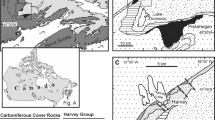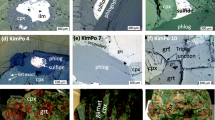Abstract
Two groups of rhyolites have been recognized at San Vincenzo (Tuscany, Italy). Group A rhyolites are characterized by plagioclase, quartz, biotite, sanidine and cordierite mineral assemblages. They show constant MgO and variable CaO and Na2O contents. Initial87Sr/86Sr ratios in group A samples range between 0.71950 and 0.72535, whereas the Nd isotopic compositions are relatively constant (0.51215–0.51222). Group B rhyolites are characterized by orthopyroxene and clinopyroxene as additional minerals, and show textural, mineralogical and chemical evidence of interaction with more mafic magmas. The Sr and Nd isotopic ratios range between 0.71283–0.71542 and 0.51224–0.51227 respectively. Magmatic inclusions of variable size (1 mm to 10 cm) were found in groups B rhyolites. These inclusions consist mainly of diopsidic clinopyroxene and minor olivine and biotite. They are latitic in composition and represent blobs of hybrid intermediate magmas entrained in the rhyolitic melts. These magmatic inclusions have relatively high Sr contents (996–1529 ppm) and Sr and Nd isotope-ratios of 0.70807–0.70830 and 0.51245–0.51252 respectively.87Sr/87Sr data on minerals separated from both group A and B rhyolites and magmatic inclusions reveal strong isotopic disequilibria due to the presence of both restitic and newly crystallized phases in group A rhyolites and due to interaction of rhyolites with a mantle-de-rived magma in group B rhyolites. Isotopic data on whole rocks and minerals allow us to interpret the group A rhyolites as representative of different degrees of melting of an isotopically fairly homogeneous pelitic source; conversely, group B rhyolites underwent interactions with a mantle-derived magma. The crustal source as inferred from isotopic systematics would be characterized by87Sr/86Sr and143Nd/144Nd ratios close to 0.7194 and 0.51216 respectively. The sub-crustal magma would have Sr isotopic composition close to 0.7077 and a143Nd/144Nd ratio greater than or equal to 0.51252. These isotopic features are different from those reported for the parental magmas postulated for Vulsini and Alban Hills in the nearby Roman Magmatic Province, and are similar to those of the Vesuvius and Ischia magmas.
Similar content being viewed by others
References
Arias C, Bigazzi G, Bonadonna FP (1981) Size corrections and plateau age in glass shards. Nucl Tracks 5:129–136
Barberi F, Innocenti F, Mazzuoli R (1967) Contributo alla conoscenza chimica, petrografica e magmatologica delle rocce intrusive, vulcaniche e filoniane del Campigliese (Toscana). Mem Soc Geol It 6:643–681
Borsi S, Ferrara G, Tongiorgi E (1967) Determinazione con il metodo K-Ar della età delle rocce magmatiche della Toscana. Boll Soc Geol It 26:403–410
Chappell BW, White AJR (1974) Two contrasting granite types. Pac Geol 8:173–174
De Paolo DJ, Wasserburg GJ (1979) Petrogenetic mixing models and Nd-Sr isotopic patterns. Geochim Cosmochim Acta 43:615–627
Dupuy C, Allegre CJ (1972) Fractionement K/Rb dans les suites ignimbritiques de la Toscane. Un exemple de rejuvenation crustale. Geochim Cosmochim Acta 36:437–458
Ferrara G (1969) Rapporti tra la composizione isotopica dello Sr ed i fenomeni anatettici nelle rocce della provincia magmatica Toscana. Rend SIMP 25:165 (abstract)
Ferrara G, Laurenzi M, Petrini R, Preite-Martinez A, Taylor HPP, Tonarini S, Turi B (1985) Isotopic evidences of interaction of K-magmas and crustal materials (Alban Hills and Vulsini District). IAVCEI, Catania
Ferrara G (1983) Utilizzazione dei dati radiometrici in rocce magmatiche: possibilità e limiti del metodo Rb/Sr. Rend SIMP 38:65–72
Franzini M, Leoni L, Saitta M (1975) Revisione di una metodologia analitica per fluorescenza X basata su una correzione completa degli effetti di matrice. Rend SIMP 31:365–378
Giraud A, Dupuy C, Dostal S (1986) Behaviour of trace elements during magmatic processes in the crust: application to the acid volcanic rocks of Tuscany (Italy). Chem Geol 57:269–288
Hawkesworth CJ, Vollmer R (1979) Crustal contamination versus enriched mantle:143Nd/144Nd and87Sr/86Sr evidences from the italian volcanics. Contrib Mineral Petrol 69:151–165
Juteau M, Michard A, Albarede F (1986) The Pb, Sr, Nd isotope geochemistry of some recent circum-Mediterranean granites. Contrib Mineral Petrol 92:331–340
Langmuir CH, Vocke JR RD, Hanson GN (1977) A general mixing equation with application to Icelandic basalts. Earth Planet Sci Lett 37:380–392
Le Bas MJ, Le Maître RW, Streckeisen D, Zanettin B (1986) A chemical classification of volcanic rocks based on the total Alkali-Silica diagram. J Petrol 27:745–750
Ludwig KR (1982) User's guide to DBAT2B, a computer program for operation on Micromass Isomass 54R mass spectrometer. US Geol Survey Open File Rep 82-1079:1–50
Mahood G, Hildreht W (1983) Large partition coefficients for trace elements in high-silica rhyolites. Geochim Cosmochim Acta 47:11–30
Marinelli G (1961) Genesi e classificazione delle vulcaniti recenti toscane. Atti Soc Tosc Sci Nat LXVIII:74–116
Miller M, Calvin F (1985) Are strongly peraluminous magmas derived from pelitic sedimentary sources? J Geol 93:673–689
Pinarelli L, Poli G (1985) Geochemical contraints on the genesis of Pliocenic acid volcanism from central Italy. IAVCEI-Giardini Naxos (abstract)
Richard P, Shimizu N, Allegre CJ (1976)143Nd/144Nd, a natural tracer: an application to oceanic basalts. Earth Planet Sci Lett 31:269
Taylor Jr HP, Turi B (1976) High δ18O igneous rocks from the Tuscan magmatic province. Contrib Mineral Petrol 55:33–54
Vollmer R (1976) Rb-Sr and U-Th-Pb systematics of alkaline rocks: the alkaline rocks from Italy. Geochim Cosmochim Acta 40:283–295
Vollmer R (1977) Isotopic evidence for genetic relations between acid and alkaline rocks in Italy. Contrib Mineral Petrol 60:109–118
Author information
Authors and Affiliations
Rights and permissions
About this article
Cite this article
Ferrara, G., Petrini, R., Serri, G. et al. Petrology and isotope-geochemistry of San Vincenzo rhyolites (Tuscany, Italy). Bull Volcanol 51, 379–388 (1989). https://doi.org/10.1007/BF01056898
Received:
Accepted:
Issue Date:
DOI: https://doi.org/10.1007/BF01056898




